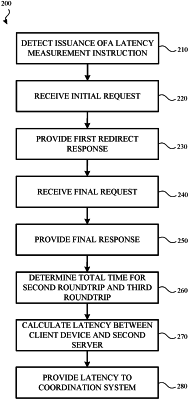| CPC H04L 67/101 (2013.01) [H04L 43/0864 (2013.01); H04L 43/16 (2013.01)] | 20 Claims |

|
1. A method, comprising:
determining that a latency measurement instruction has been issued;
receiving, at a first server, a first request from a client device;
in response to receiving the first request from the client device, providing, by the first server, a first redirect response to the client device, the first redirect response causing the client device to submit a second request to a second server;
determining, at the first server, a first latency measurement between the client device and the first server based on at least a first time between when the first request is submitted from the client device and received at the first server;
receiving, at the first server, a final request, the final request being provided to the first server from the client device based on the client device receiving a second redirect response from the second server;
determining, at the first server, a second latency measurement between the client device and the second server based, at least in part, on a second time between when the first redirect response is provided to the client device and when the final request is received by the first server;
determining that the second latency measurement is an improvement over the first latency measurement; and
providing instructions to the client device to issue subsequent requests to the second server based on the determination that the second latency measurement is an improvement over the first latency measurement.
|